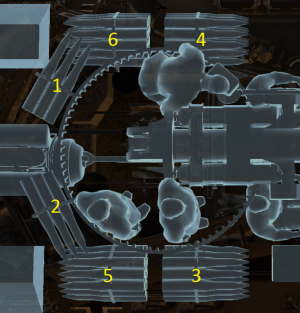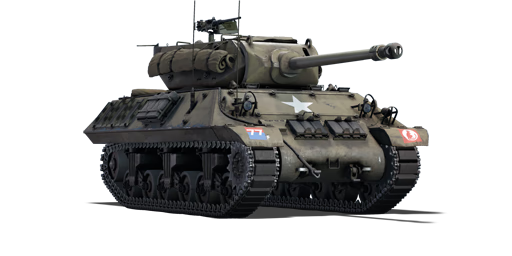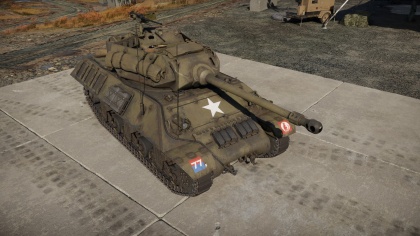Achilles (65 Rg.)
Contents
Description
The Achilles 65 Reg. (technically 17 pounder, Self-Propelled M10 Achilles (65th Anti-Tank Regiment)) is a premium Rank III British tank destroyer with a battle rating of 4.0. It was introduced in Update 1.53 "Firestorm" and is one of the first British tanks introduced in the game. It is an Achilles tank destroyer with insignia of 7th Armored Division, 65th Anti-Tank Regiment "Norfolk Yeomanry".
The Achilles is based on the American M10, but carries 17-pounder as the main armament, making it an effective tank destroyer. Thanks to a well assigned BR you won't feel in the wrong game even when facing higher rank tanks. For a Battle Rating 4.0, you have a plenty of firepower, especially once you have unlocked the Mk.8 APCBC shot, which is more effective against the T-34 sloped armour. The 17-pdr literally cuts through enemy Panzer III and IV (the shots enter the front and exit from the rear) so try to aim vital points to cause the maximum damage (first shot to the turret to disable enemy firepower). The T-34 is a bigger problem due to its sloped armour. When facing Russians your first shot should be always to the gunner. The Mk.8 APCBC is quite able to penetrate the T-34 glacis even from distance but keep in mind that the damage you'll cause is unreliable (sometimes 3 or more shots are required to destroy a T-34, sometimes one shot is enough). The M10 mobility is not outstanding but the Achilles is pretty capable to carry you where you want to go.
Protection is not good. The sloped armour and the track links added to the front will protect you from some low calibre shots but the vast majority of your enemies'll be able to easily destroy you. Side armour is paper thin. The high profile and the very slow turret traverse (man powered) are not good for close range combat so avoid deep flanking tactics.
General info
Survivability and armour
Armour type:
- Rolled homogeneous armour
- Cast homogeneous armour (Gun mantlet, Transmission area)
- Structural steel (Counterweight)
| Armour | Front | Sides | Rear | Roof |
|---|---|---|---|---|
| Hull | 38.1 mm (55°) Front glacis 50.8 mm (7-55°) Transmission area |
19.05 mm (38°) Top hull 25.4 mm Bottom hull |
19.05 (28-33°) Top Hull 25.4 mm (7-52°) Bottom hull |
19.05 mm Front 9.5 mm Rear |
| Turret | 25.4 mm (66-88°) Turret front 57.15 mm (0-47°) Gun mantlet |
25.4 mm (22-46°) | 25.4 mm (1-29°) Turret rear 50 mm (0-50°) Counterweight |
N/A |
Notes:
- Suspension wheels and tracks are 20 mm thick while the bogies are 10 mm thick.
- Belly armour is 12.7 mm thick.
- Hull rear sides are protected by attached grousers that gives 20 mm of extra armour.
- Tracks placed on the front transmission area provide 30 mm extra armour.
Mobility
| Mobility characteristic | ||
|---|---|---|
| Weight (tons) | Add-on Armor weight (tons) |
Max speed (km/h) |
| 29.6 | 0.3 | 45 (AB) |
| 41 (RB/SB) | ||
| Engine power (horsepower) | ||
| Mode | Stock | Upgraded |
| Arcade | 587 | 717 |
| Realistic/Simulator | 363 | 410 |
| Power-to-weight ratio (hp/ton) | ||
| Mode | Stock | Upgraded |
| Arcade | 19.66 | 24.22 |
| Realistic/Simulator | 12.26 | 13.85 |
Armaments
Main armament
| 76 mm OQF 17-pounder | |||||
|---|---|---|---|---|---|
| Capacity | Vertical guidance |
Horizontal guidance |
Stabilizer | ||
| 50 | -10°/+30° | ±180° | N/A | ||
| Turret rotation speed (°/s) | |||||
| Mode | Stock | Upgraded | Prior + Full crew | Prior + Expert qualif. | Prior + Ace qualif. |
| Arcade | 2.70 | 3.70 | _.__ | _.__ | _.__ |
| Realistic | 2.70 | 3.10 | _.__ | _.__ | _.__ |
| Reloading rate (seconds) | |||||
| Stock | Prior + Full crew | Prior + Expert qualif. | Prior + Ace qualif. | ||
| 8.70 | _.__ | _.__ | _.__ | ||
Ammunition
| Penetration statistics | |||||||
|---|---|---|---|---|---|---|---|
| Ammunition | Type of warhead |
Penetration in mm @ 90° | |||||
| 10m | 100m | 500m | 1000m | 1500m | 2000m | ||
| Shot Mk.6 | AP | 160 | 157 | 133 | 112 | 96 | 86 |
| Shell Mk.1 | HE | 9 | 9 | 9 | 9 | 9 | 9 |
| Shot Mk.4 | APC | 165 | 160 | 138 | 108 | 94 | 81 |
| Shot Mk.8 | APCBC | 171 | 168 | 156 | 143 | 130 | 120 |
| Shell details | ||||||||||
|---|---|---|---|---|---|---|---|---|---|---|
| Ammunition | Type of warhead |
Velocity in m/s |
Projectile Mass in kg |
Fuse delay
in m: |
Fuse sensitivity
in mm: |
Explosive Mass in g (TNT equivalent): |
Normalization At 30° from horizontal: |
Ricochet: | ||
| 0% | 50% | 100% | ||||||||
| Shot Mk.6 | AP | 883 | 7.7 | N/A | N/A | N/A | -1° | 47° | 60° | 65° |
| Shell Mk.1 | HE | 883 | 7.0 | 0.4 | 0.5 | 580 | +0° | 79° | 80° | 81° |
| Shot Mk.4 | APC | 883 | 7.7 | N/A | N/A | N/A | -1° | 48° | 63° | 71° |
| Shot Mk.8 | APCBC | 883 | 7.7 | N/A | N/A | N/A | +4° | 48° | 63° | 71° |
| Smoke characteristic | ||||||
|---|---|---|---|---|---|---|
| Ammunition | Velocity in m/s |
Projectile Mass in kg |
Screen radius in m |
Screen time in s |
Screen hold time in s: |
Explosive Mass in g (TNT equivalent): |
| 17pdr Shell SS Mk.1 | 754 | 8.4 | 13 | 5 | 20 | 50 |
Ammo racks

| Full ammo |
1st rack empty |
2nd rack empty |
3rd rack empty |
4th rack empty |
5th rack empty |
6th rack empty |
Visual discrepancy |
|---|---|---|---|---|---|---|---|
| 50 | 48 (+2) | 45 (+5) | 34 (+16) | 23 (+27) | 12 (+38) | 1 (+49) | Yes |
Turret empty: 45 (+5)
Machine guns
| 12.7 mm M2HB | ||||||
|---|---|---|---|---|---|---|
| Pintle mount | ||||||
| Capacity (Belt capacity) | Fire rate (shots/minute) |
Vertical guidance |
Horizontal guidance | |||
| 300 (200) | 577 | -10°/+70° | ±60° | |||
Usage in the battles
The Achilles is best used for sniping and for shoot and scoot tactics. Find a good spot where to shoot at enemies, aim carefully (RB need a good use of mils range estimation) and enjoy the fireworks!
Keep in mind the low fire rate (compared to other 17-pdr AFVs). Once you have destroyed (or damaged) the enemy the best thing to do is to relocate. Don't stay in the same spot for too long: you have weak armour and open top. Artillery barrages will cripple your TD and kill your crew.
Another thing to think about is the turret traverse. Yes... It is **really** slow. Therefore, you need to make some changes to your play style. If you need to target an enemy quickly, do not rely on the turret. Instead, traverse the entire tank so that your hull is facing the enemy head on, similar to turretless, casemate style tank destroyers. To avoid situations like this, you should stay way back, avoiding urban areas and other areas where you will be flanked easily.
Pros and cons
Pros:
- Good gun (17-pounder!)
- High level of penetration. Will often pass through the front of lighter vehicles and leave through the back.
- Premium vehicle - instant access to the best shell (Shot Mk.8)
- Good speed
- 5 crew members
- .50 cal Heavy machine gun on top to fight lightly armoured tanks and aircraft
- Sloped armour makes incoming rounds more likely to ricochet
- Spare tracks that provided some limited protection on the front and on the rear section of the side armour.
- Good gun depression
Cons:
- Armour is rather thin
- Big ammo racks
- Open top turret makes it vulnerable to artillery and strafing planes
- Very slow turret traverse
- Lack of explosive filler for AP shells
- Handling is poor on some rough terrain before mobility modifications are researched
- Reverse speed is bad
- Low ammo reserve for Commander's machine gun (300 rds total)
History
Development
The M10 tank destroyer was developed in 1942 to fulfill the anti-tank doctrine established by the US military. The doctrine, creating the tank destroyer force, was established with the objective to stop German blitzkrieg tactics by attacking the tanks. Unlike the other armoured fighting vehicles in the theater, the tank destroyers were made to be placed in reserves to counter any breach in the front lines by taking out the enemy with ambushes. This role led to the desire for a fast vehicle with a powerful gun, armour was not a concern due to the emphasis in speed. The design ended up taking a turret design developed from the M6A1 Heavy Tank and the body from the M4A2 Sherman, this with the 3-inch 1918 gun, provided the backbone of the American tank destroyer force in much of World War II. In total, 6,706 M10s and its variants were produced between September of 1942 to 1943 of the same month.
British Use
These M10s were given out to America’s allies, though the British were the most well-known of these users, receiving about 1,650 M10s from the Americans from 1943 onward. The British designated the M10s under their service as the Achilles and unlike popular usage, was called that for both the 3-inch gun variant (Achillies I/II) and the variant mounting the 17-pounder (Achillies Ic / IIc). Though in most usage, the vehicle was called the 17pdr M10, or 17pdr SP M10, or even the "Firefly", despite that name being used for a different design.
The British first received the M10s with the 3-inch cannons, which were much more powerful than the British tank armament at the time, giving them an edge in many tank confrontations in the North African Campaign. It was around 1943 that a conversion is done onto the M10 to increase its firepower capabilities against the gradually upgraded German tank designs such as the Tiger I and the Panthers. The conversion used one of the best Allied anti-tank guns at the time, the 17-pounder, which could penetrate about 140 mm of armour at 500 meters away with APCBC rounds, and 209 mm at the same distance with APDS rounds (Armour-Penetrating Discarding Sabot). The conversion done onto the M10 also required a counterweight to be placed on the 17-pounder to compensate the heavier weight of the 17-pounder compared to the 3-inch gun. This gave the M10 Achilles a much more defining profile and attempts were made to hide this larger cannon length with optical illusion. Aside from the gun conversion, the M10 Achilles also had an extra 17 mm of armour welded onto the front and sides of the hull for added protection, plus a 20 mm shield on the top of the turret to compensate for the open-turret design. About 1,000 M10 Achilles with the 17-pounders were ordered, but by D-Day, only 124 were available and 816 were done by the end of the year. The low number of these converted Achilles made meant that any lost units were hard to replace with a 17-pounder one, and the disgruntled crew would be issued a M10 with a 3-inch gun instead. In the end, about a total of 1,000 Achilles were converted into 17-pounder ones by the end of World War II, making the M10 Achillies the second-most numerous design to mount the 17-pounder, coming before the Sherman Firefly.
The Achilles were issued out as part of the Royal Artillery in armoured divisions in anti-tank regiments. One of such regiments was the 65th Anti-Tank Regiment assigned to the 7th Armoured division during 1942 and onward until the end of the war.
Combat Usage
The British doctrine with the Achilles differed from the Americans who saw it as a reserve tank destroyer, the British viewed it as a mobile anti-tank gun, thus the Achilles served in a role akin to the StuG III in German service, moving the 17-pounder into position to take a shot on incoming German Tiger or Panther tanks. These Achilles were used more with Churchill tank units rather than the medium tanks due to the lack of 17-pounder equipped on Churchills while the medium tanks have the Firefly available for use. Disadvantages with the M10 Achilles design were carried over from the original, the slow turret traverse speed, high profile, and open-top turret made it a rather harder vehicle to use than a regular tank, but it still had it advantages and was still suitable for the role it had.
The Achilles were deployed on D-Day onward in artillery forces in anti-tank regiments in armoured divisions. A typical anti-tank regiment would have four batteries, two with towed 17-pounders, one equipped with 17-pounder Achilles, and another with regular M10s with the 3-inch gun (though replaced with another Achilles unit once more were available). A notable event with the Achilles was during Operation Charnwood, where Achilles in the 62nd Anti-Tank Regiment fought off a German counterattack comprising of Panzer IVs and Panthers from the 12th Panzer Regiment were routed by the Achilles 17-pounder fires, destroying about 13 German tanks with the loss of four Achilles knocked out and four more damaged.
Media
An excellent addition to the article will be video guides, as well as screenshots from the game and photos.
Read also
[Devblog] Pioneering British Tanks in War Thunder with developer's answers
Sources
Paste links to sources and external resources, such as:
- topic on the official game forum;
- other literature.
| Britain tank destroyers | |
|---|---|
| Infantry tank derivatives | Archer · Gun Carrier (3-in) |
| Light tank derivatives | Alecto I |
| M10 Achilles | Achilles · Achilles (65 Rg.) |
| Centurion derivatives | FV4005 · Conway |
| ATGM | Swingfire · Striker |
| Other | Tortoise · ▄M109A1 |
| Canada | QF 3.7 Ram |
| South Africa | G6 · ZT3A2 |





